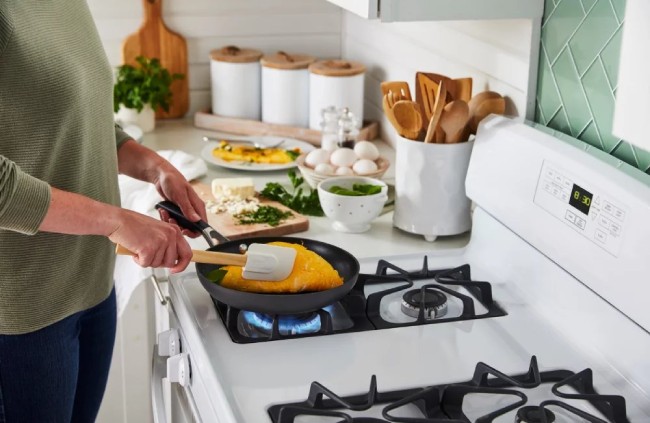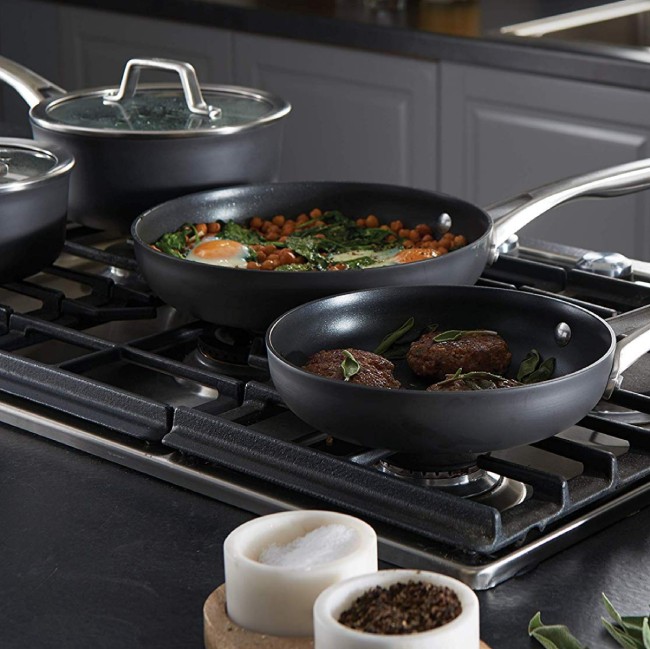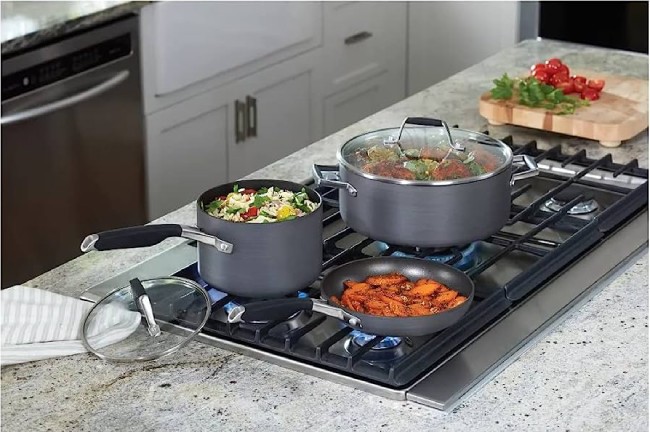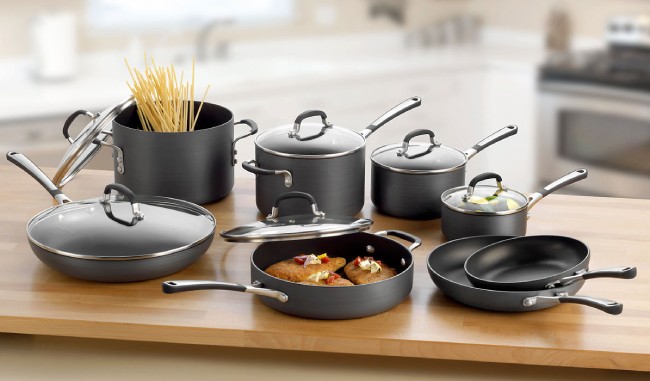Can you use Calphalon on gas stoves? Absolutely! If you are looking for versatile cookware that can be used on a gas stove, then one of the best choices you can make is to opt for Calphalon cookware.
Calphalon pots and pans are designed to work well with all stovetops, including gas stoves, so you don’t have to worry about your food burning or sticking when making delicious dishes. In this blog post, we’ll look at why Calphalon is perfect for cooking on a gas stove and offer some tips on getting the most out of your experience using it.
Understanding Calphalon Cookware
Brief history and popularity of Calphalon cookware.
Calphalon’s roots trace back to 1963 when Ronald M. Kasperzak founded it under Commercial Aluminum Cookware, primarily supplying to the restaurant industry and other professional food services.
The brand took a significant leap forward in 1968 when Kasperzak invented hard-anodized aluminum cookware, a process borrowed from the aerospace industry. This innovation made the cookware more durable and resistant to corrosion and warping, marking the birth of Calphalon as we know it today.

Different types of Calphalon cookware: Hard-Anodized Non-stick, Stainless Steel, Ceramic, and Cast Iron.
Hard-Anodized Non-stick: This type of Calphalon cookware is made from aluminum that has been anodized with a hard coating. The result is a durable cooking surface that is resistant to scratches and other damage and ideal for use on gas stoves. Hard-anodized non-stick cookware also features a non-stick interior coating, allowing easy cleanup.
Stainless Steel: This type of Calphalon cookware is made from stainless steel and features a non-stick interior, making it ideal for use on gas stoves. The stainless steel construction makes the cookware highly durable and resistant to rust and corrosion.
Ceramic cookware is created by baking a non-stick surface onto a metal substrate. This type of cookware is ideal for gas stoves due to its heat retention and scratch resistance.
Cast Iron: Cast iron cookware is a timeless classic, dating back centuries. It’s ideal for slow cooking due to its heat retention characteristics and can be used on gas stoves.
Can you use Calphalon on a gas stove?
Yes, it is possible to use Calphalon cookware on a gas stove. However, it is essential to note that when using Calphalon on a gas stove, you should always use low heat settings and ensure the flame does not come in contact with any part of the cookware.
This will help ensure your cookware maintains its non-stick properties and lasts many years. Additionally, avoid sliding or dragging your Calphalon cookware across the stovetop, as this can cause scratches on the surface.
Calphalon Cookware: Material and Design
Detailed discussion on Hard-Anodized Non-stick Calphalon cookware.
Calphalon cookware is made from anodized aluminum with a non-stick coating. This makes it extremely durable and easy to clean. Additionally, the design of the pot or pan also helps it stay cooler for longer when you’re cooking on a gas stove, reducing the risk of burning food. The material is resistant to scratching and denting, so it will hold up to regular use and can be used on various stovetops, including gas.
When using Calphalon cookware for gas stove, you’ll want to use low to medium heat settings so the pan doesn’t get too hot. Also, ensure you preheat the pan before adding ingredients so your food cooks evenly. This way, you can get the most out of your Calphalon cookware and enjoy making delicious meals on a gas stove.
I am exploring the anodization process and its benefits for cooking on gas stoves.
Calphalon cookware is made using anodization, a process that bonds the aluminum to the surface of the pan. This helps form a firm layer that resists corrosion and damage.
It also leads to better heat distribution due to the even thickness of the material, which can help cook food more evenly on a gas stovetop. Additionally, the design of Calphalon cookware makes it less likely to warp or bend due to the extra strength provided by the anodization process.

Impact of Calphalon’s design on cooking and heat distribution.
The design of Calphalon cookware is also essential when it comes to cooking on gas stoves. The low-profile shape helps keep the heat from being concentrated in one area, reducing the risk of burning food and making it easier to control heat levels. Additionally, the non-stick coating ensures you won’t have trouble with stuck-on bits of food, making cooking easier.
How to Use Calphalon on Gas Stove?
Steps to preheat Calphalon cookware on a gas stove.
- Place your cookware on a dry, level burner.
- Turn the gas burner to its lowest setting and let it heat up for at least two minutes.
- Gradually increase the flame until you can feel heat radiating from the bottom of the pan. It typically takes about five minutes for Calphalon cookware to heat up.
- While the cookware is preheating, keep your hand away from the handle and keep all flammable materials away from the burner’s flame.
- Once preheated, turn off the gas and remove your cookware from the burner. It’s now ready to use for cooking!
Following these steps, you can safely and effectively use Calphalon cookware on a gas stove. Remember, never leave your Calphalon cookware unattended on a gas burner. It’s also important to read the instructions with your cookware for best results and safety!
Importance of using appropriate heat settings.
Using the appropriate heat setting when preheating Calphalon cookware on a gas stove is very important. Using too high of a heat setting can damage the non-stick coating, while using too low may lead to uneven cooking. Start with the lowest flame possible and increase it gradually until you can feel heat radiating from the bottom of the pan.
Guidelines for using butter or oil on Calphalon cookware.
When using butter or oil on Calphalon cookware, you should always wait until the pan is preheated before adding it. This will ensure that your food won’t stick and burn. Additionally, it would help if you never used aerosol cooking sprays, as they may damage the pan’s finish and create a sticky residue.
Caring for Calphalon: Cleaning and Storing
Instructions for cleaning Calphalon cookware after use.
- Clean cookware before storing: Immediately after use, allow cookware to cool and hand wash with warm soapy water. Use a nonabrasive sponge or cloth for cleaning to protect the finish from damage.
- Do not put Calphalon in the dishwasher: Hand washing is recommended since excessive heat and detergents can damage the finish.
- Dry thoroughly: To avoid water spots, allow Calphalon to air dry after washing and storing it.
Advice on storing Calphalon cookware to avoid damage.
- Avoid stacking: When not in use, store Calphalon cookware away from other metal objects to prevent scratching and pitting the surface.
- Use a soft cloth: Store Calphalon with material between each piece of cookware to protect against scratches and dents.
- Place on stove or shelf: To avoid warping and chipping the cookware, store Calphalon in a dry area on the stove or on shelves.
- Check for gas compatibility: While using Calphalon on a gas stove, always ensure that your cookware is compatible with your cooking surface.
Tips and Tricks for Cooking with Calphalon on a Gas Stove
Tips for achieving efficient and safe cooking with Calphalon cookware on a gas stove.
- Use the right size burner: Make sure your Calphalon cookware is centered on the gas stove burner and is the same size or slightly larger than the pot/pan. Using a burner that is too small may cause hot spots, which can lead to uneven cooking results.
- Temperature control: When using Calphalon cookware on a gas stove, it is essential to monitor the temperature carefully, as heat can build up quickly and cause burning. To avoid this, use medium-low or medium heat rather than high heat.
- Season your pan: Before using your Calphalon cookware for the first time, season the pan by coating it with oil and heating it for a few minutes. This will help create a non-stick coating on the surface and prevent food from sticking to the pan.
- Use an appropriate amount of oil: To get the most out of your Calphalon cookware, use a proper amount of oil or butter when cooking. Too much fat can cause splattering and smoking, while too little can lead to sticking.
- Cleaning and Maintenance: After cooking with your Calphalon cookware, ensure it is properly cleaned and stored away. To extend the life of your cookware, avoid using abrasive cleaning methods, as this can cause scratching or remove the non-stick coating on the pan’s surface.
Practical cooking examples and ideal heat settings for different dishes.
- Stir-Fry: When making a stir-fry, use medium-high heat and add the vegetables first, followed by meat or chicken. Cook for 3-4 minutes until the vegetables are tender, then add sauces or seasonings.
- Omelets: To make an omelet on your Calphalon cookware, use medium-low heat and add 1-2 tablespoons of butter or oil to the pan. Crack open two eggs and scramble them together before pouring them into the pan. Cook for 3-4 minutes until golden brown on both sides.
- Pancakes: For making pancakes with your Calphalon cookware, use medium-high heat and begin by swirling two tablespoons of butter or oil onto the pan. Pour 1/4 cup of pancake batter into the center and spread evenly with a spoon. Cook until golden brown, about 1-2 minutes per side.

Pros and Cons of Using Calphalon on Gas Stoves
Discussion on the advantages of using Calphalon cookware on gas stoves.
One of the advantages of using Calphalon cookware on a gas stove is the heat control that it provides. Since gas stoves provide direct, uniform heat to your cookware, you can easily adjust the temperature setting to achieve optimal results with each recipe. This makes it easier for novice and experienced chefs to get consistent results when cooking their favorite recipes.
Calphalon cookware is also designed to be non-stick, which makes it easier to clean up. This prevents food from sticking to the pan and burning since the heat is evenly distributed across the cookware’s surface. The non-stick surface also ensures that your meals will not end up with a greasy aftertaste.
On the other hand, there are some drawbacks to using Calphalon cookware on a gas stove. For starters, it is essential to note that while these pans are designed for high-temperature cooking, extreme heat can easily damage them.
Additionally, since gas stoves tend to produce more intense heat than electric and induction stoves, keeping a close eye on your cookware is essential to ensure it stays cool. Finally, since Calphalon pans are not induction capable, they should not be used on induction stovetops.
Potential drawbacks and how to avoid them.
The most crucial point to consider when using Calphalon cookware on a gas stove is avoiding extreme heat. Since these pans are not designed for use on an open flame or over direct heat, keeping your burner settings low and monitored closely is essential.
Additionally, if you are cooking with higher amounts of fat (such as butter or oil), it is best to use a lower setting and watch the pan closely. This will ensure that the grease does not start to burn, which can ruin the flavor of your dishes.
FAQs about Can you use Calphalon on gas stove?
Is Calphalon safe for use on electric stoves as well?
Yes, Calphalon is safe for use on both electric and gas stoves. The materials used in constructing its cookware are designed to withstand high temperatures and extreme heat transfer. However, it is essential always to follow the instructions provided with the item for the best results.
Additionally, when using Calphalon on a gas stove, ensure the heat setting is no higher than medium to avoid overheating and possible damage.
How do I keep my gas stove clean when using Calphalon?
Calphalon cookware is designed to be non-stick, so it should not leave residue on the stovetop. However, to maintain a clean cooking surface and keep your Calphalon cookware in good condition, you should clean your gas stove after each use. Wipe down with a damp cloth or sponge, then dry thoroughly. This will help ensure that your Calphalon cookware performs optimally every time.
How to prevent food from burning in Calphalon cookware?
It is essential to monitor your food while cooking with Calphalon cookware constantly. When using a gas stove, set the heat no higher than medium and adjust it as necessary throughout the cooking process if you notice the food is cooking too quickly or burning. Additionally, occasionally stir and turn your food during cooking to help evenly distribute heat and prevent burning.
Conclusion on Can you use Calphalon on gas stove?
The answer to the question “Can you use Calphalon on gas stoves” is yes, you can. Calphalon cookware is designed for all types of stovetops, including gas stoves. It is vital to ensure that your pan or pot has a flat bottom and securely fits on the burner to heat and cook your food correctly.
It would also help always to use low to medium heat when cooking with Calphalon on a gas stove, as high temperatures can lead to warping or discoloration. With the proper care and usage of your Calphalon cookware, you can enjoy delicious meals cooked on your gas stove for years to come!
Read more:

